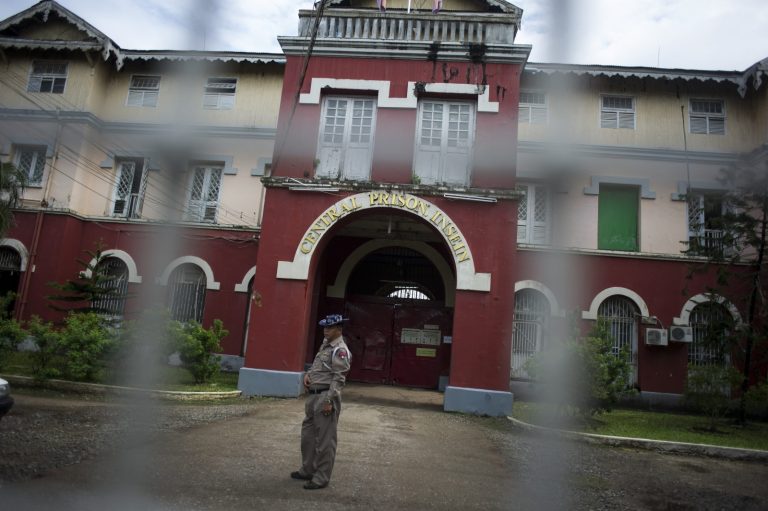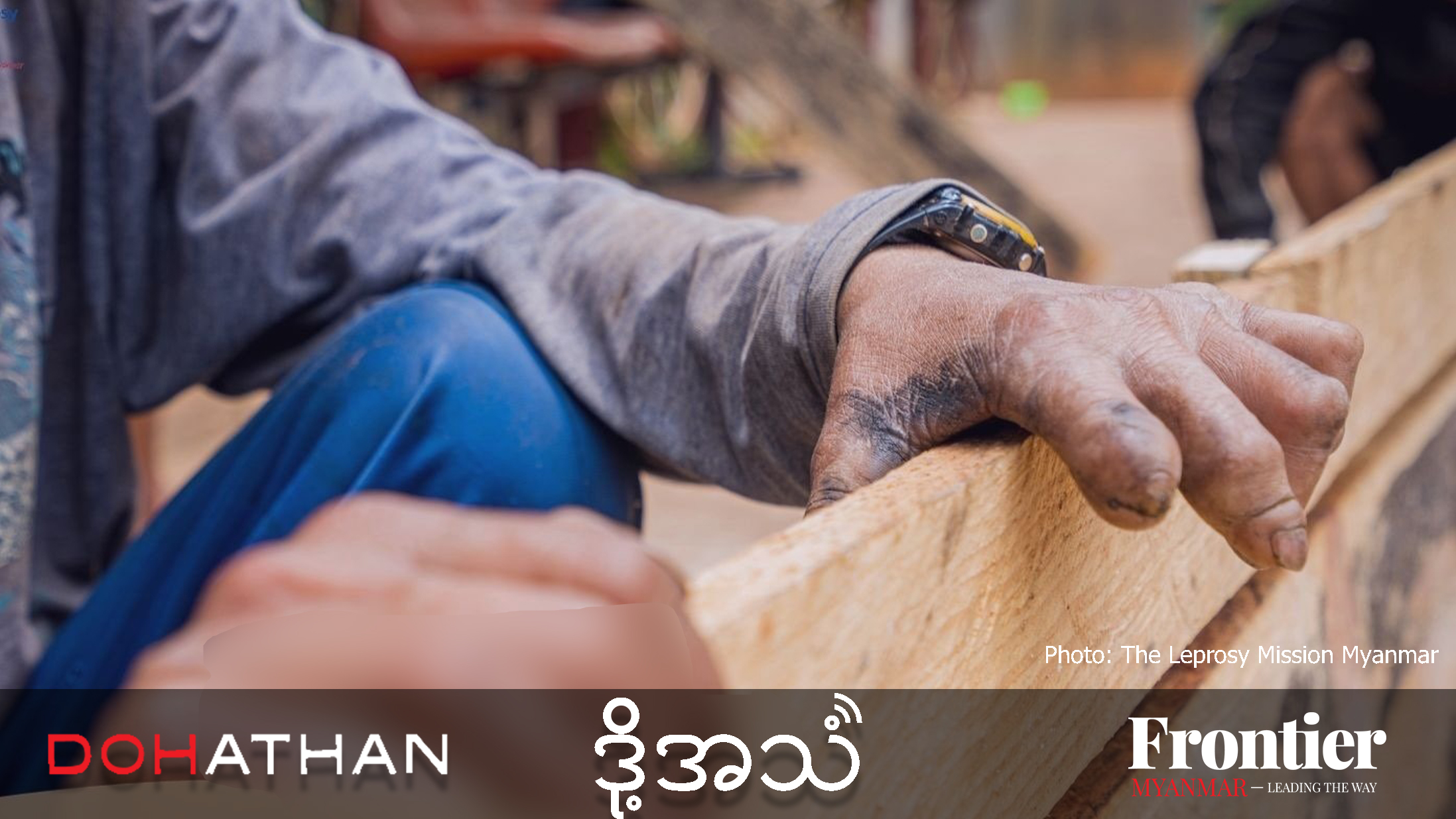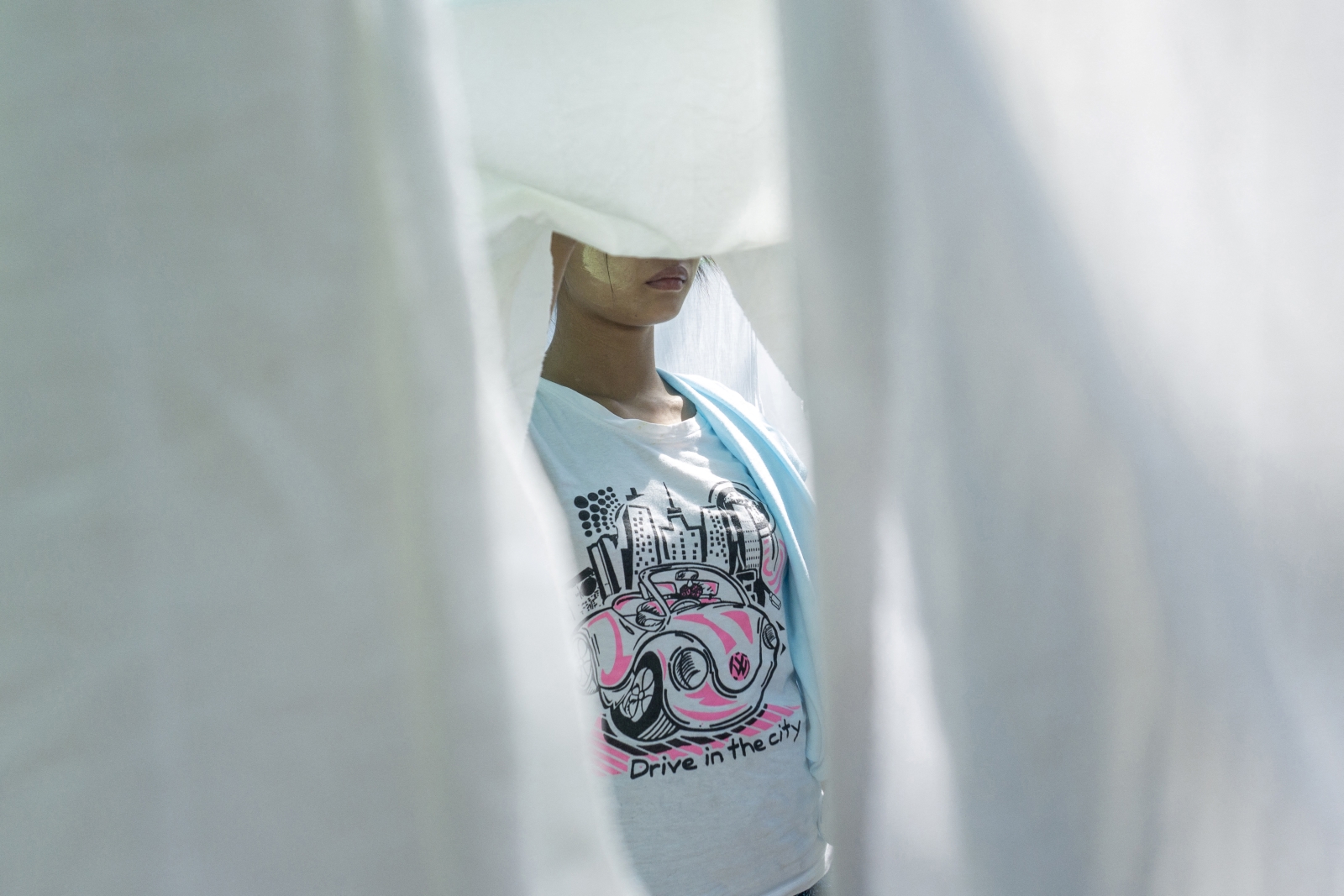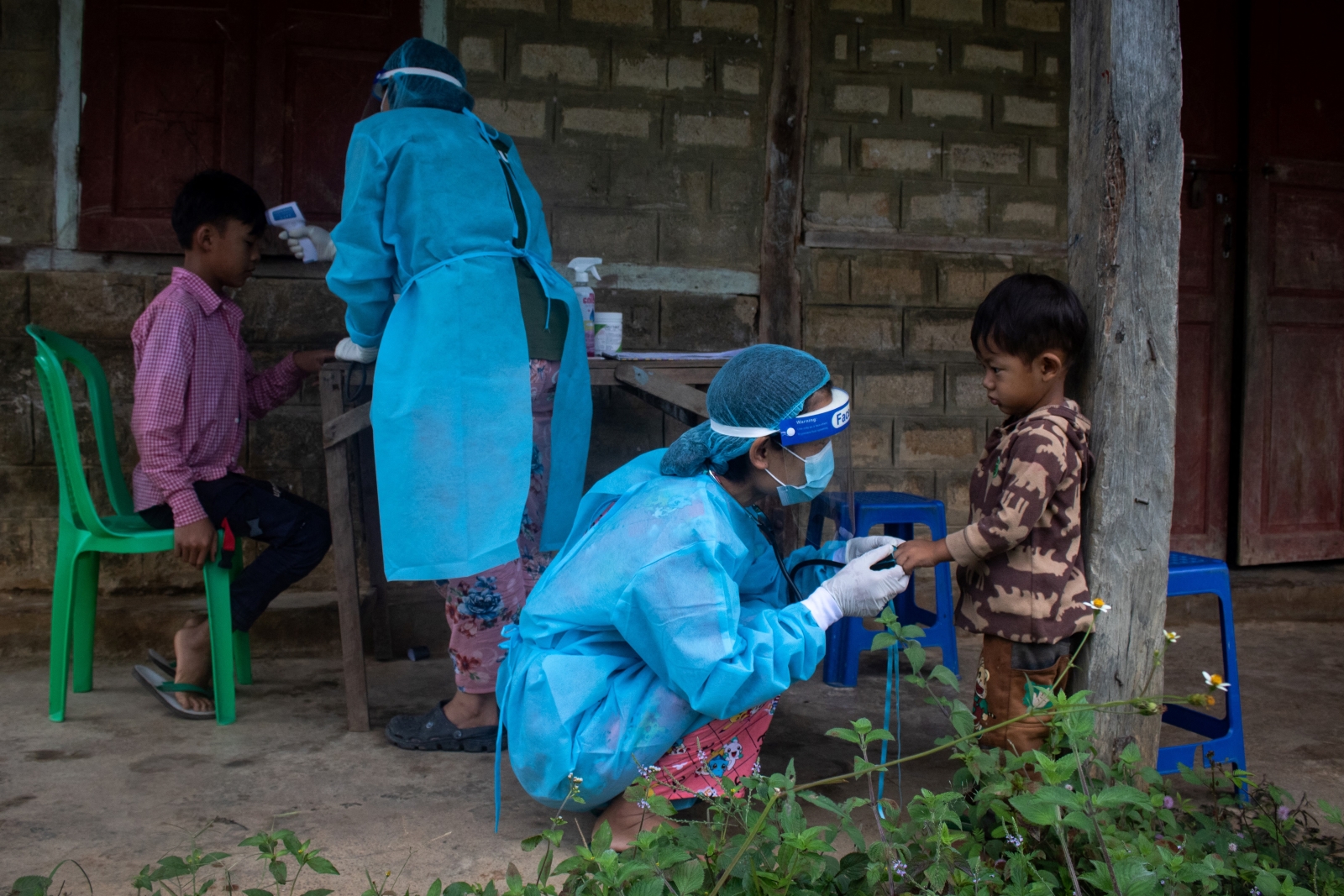Leprosy patients have been left in limbo by the post-coup healthcare collapse, and experts say an apparent decrease in numbers reflects dwindling state capacity, not fewer patients.
By MOE THAW DAR SWE | FRONTIER
Ko Naing* first noticed red spots on his body in 2020, but assumed it was a harmless skin rash, perhaps caused by his frequent drinking.
“Then, the spots started increasing,” said the 38-year-old car mechanic, who had moved from Myanmar to Malaysia in 2007. Growing alarmed, he went to a clinic near his home in the city of Alor Setar, where the doctor suggested he go to a general dermatology hospital.
But the hospital was over two hours away and lockdowns were coming into effect across the country as COVID-19 took the world by storm. On top of that, Ko Naing’s passport had expired, further restricting his ability to travel. After a year without treatment, his condition worsened, and he finally returned to Myanmar on a COVID-19 relief flight in late 2021, after paying a fine for his expired passport.
“By then, I couldn’t stand up. I had knobs all over my body with pus coming out of them and my whole body ached,” he recalled.
Like all other passengers during the pandemic, Ko Naing was obligated to quarantine on arrival in Yangon. He went to a government-run facility in Hlaing Township, where he told a doctor about his condition, who suggested he go to the special dermatology centre at Yangon General Hospital.
“I only found out what my disease was last year [2022], and they said it’s already level five – severe. At level six, I could lose my arms and legs,” he said.
But despite the severity of his case and urgent need for treatment, Ko Naing has never been admitted to a hospital for round-the-clock care, as many healthcare professionals would recommend.
“I want to be treated at a leprosy hospital, but for now they just give me medicine and send me away,” he said.
After the military seized power in February 2021, the public healthcare sector collapsed due to a mass strike of civil servants protesting against the coup, dubbed the Civil Disobedience Movement, and a regime crackdown on parallel health services. This has given an opening for the return of communicable diseases like leprosy or those prevented by vaccines.
Faced with nationwide armed resistance, the regime’s tenuous grasp on power and the debilitating strike means healthcare officials are unable to collect accurate data on the rate of leprosy infections nationwide. Patients and volunteers said the junta is also unable to provide adequate care to those suffering from leprosy.
Officials from the regime’s health ministry did not respond to requests for comment.
The effects of leprosy
Leprosy is a chronic infectious, and heavily stigmatised, disease caused by a slow-growing bacteria. It can be treated and cured if caught early. But if left untreated, it can result in growths and swelling on the skin, numbness and paralysis of the hands and feet, blindness, and chronic pain or burning sensations. In some of the most severe cases, limbs may need to be amputated.
The disease spreads via droplets from the nose and mouth – but is significantly less contagious than previously thought – and can lie dormant for years before symptoms begin to show.
Leprosy has been recorded in human societies since ancient history, but in 2000, the World Health Assembly declared that it was no longer a global public health problem. However, some countries were left behind. As of 2020, Myanmar was among the group of 23 countries responsible for 95 percent of the world’s leprosy cases, according to the World Health Organization. This despite the fact that the previous military regime declared the disease “eliminated” in 2003.
This declaration seems to have made the government neglect the problem.

“To be honest, since 2003, the number of leprosy-related doctors in our country has decreased, not increased,” said Dr Saw Sar Mular, who has been treating leprosy patients since 2007 and recently resigned from the Mawlamyine Christian Leprosy Hospital, in the capital of Mon State.
“Before 2003, there was a lot of awareness about leprosy. Around 1990, when I was young, government employees came to schools and told us about leprosy. They checked each one of us… After 2003, they no longer did this grassroots work,” he said.
Still, leprosy rates were noticeably declining during the failed democratic transition between 2011 and 2021, dropping from 3,082 new cases in 2011 to 1,877 cases in 2020. Since the coup, those numbers have dwindled even more – to 595 new cases in 2021 and 1,234 cases last year – but there are reasons to believe that’s largely because patients aren’t being found or treated.
“It’s not that patients are decreasing because they’re being cured, it’s that patients aren’t receiving treatment at all. At least 1,000 people are missing from the data,” said U Tun Myat*, the director of a charity group that helps leprosy patients, who asked to withhold the name of his organisation.
Frontier understands there were 775 new patients identified in Yangon alone in 2023, as of the end of November, although those numbers haven’t been made public yet.
In addition to the crumbling healthcare system, Tun Myat said patients could be falling by the wayside because several million people have been displaced from their homes due to the conflict. Moreover, with the economy in free-fall, people suffering from diseases are also unable to afford medical treatment or travel costs.
“There are patients, but they’re missing, and our concern is how many people are spreading the disease to others,” Tun Myat said.
U Swe Win* is one such patient who has fallen through the cracks, after contracting leprosy eight years ago. For most of that time, he was able to manage his leprosy with regular treatment and medication. But six months ago, the 56-year-old had to get both feet amputated at the ankle at a hospital in Ayeyarwady Region, where he lives. He’s also going blind, and was unable to walk even before his amputations, due to chronic non-healing ulcers on his feet.
His family lives in abject poverty – his wife earns a meagre living collecting garbage at the local rubbish dump, while their two children sell clothes at a shop rather than going to school.
“He had a bad ulcer on his left ankle that needed to be amputated and sores around both ankles. His left leg was very swollen and the smell was very bad,” said a close friend who helped raise money for Swe Win’s medical bills.
Before amputating his leg at the township orthopedic hospital, he contacted two leprosy hospitals – the state-run Yay Nant Thar Hospital in Mandalay Region and the private Mawlamyine Christian Leprosy Hospital in Mon – but neither would accept him due to staff shortages. He needed K300,000 [US$88 at the market rate] from donors to cover his medical expenses, but his friend said he’ll need more operations in the future.
“He can’t see well, he’ll need to have surgery on his eyes, but he can’t afford it so he might lose both eyes,” the friend said, adding that the right foot will need to be operated on again as well.
Health care collapse
Saw Sar Mular said the Yay Nant Thar Leprosy Hospital is “no longer functional”, in part because one of the top leprosy doctors there joined the CDM.
The situation at the Mawlamyine hospital seems to be more complicated. Saw Sar Mular referenced a disagreement with the management, which he declined to elaborate on, but also said he quit in order to start a mobile clinic to better reach patients.
“I quit from the Mawlamyine hospital but I’m still doing my job,” said Saw Sar Mular. “Now it’s more difficult for patients to come to me. Little by little, they came less and less, so I decided that it was better for me to go to them.”
He said as part of his mobile programme, he also trains health workers on the basics of leprosy care.
“In turn, they can give training to others,” he said. “I can’t stay long, but if they have any questions they can contact me via mobile phone apps and I will guide them through what they need.”
Saw Sar Mular said that his mobile programme still receives support from the Leprosy Mission, an international NGO which also funds the Mawlamyine hospital. Neither the Leprosy Mission nor the Mawlamyine Christian Leprosy Hospital responded to requests for comment.
In October, Frontier attempted to visit the special dermatology department at Yangon General Hospital, briefly speaking to a leprosy inspector. He said the only treatment provided is a free multi-drug therapy given to the hospital by the WHO, and declined to be interviewed further.

But Tun Myat, from the anonymous charity group, estimated that around 70pc of new leprosy patients are unable to get the multi-drug therapy in their township or neighbouring townships, saying the medicines are only available in 25 of the country’s 330 townships.
“It’s difficult for patients to travel across townships to get the medicines,” because of the conflict, he said.
Tun Myat said his organisation knows of new patients in Sagaing, Magway, and eastern Bago regions and southern Shan State – all areas that have been heavily affected by the post-coup conflict – but they can’t be reached for treatment.
Saw Sar Mular agreed.
“The medicines are available but it’s difficult for them to come get them,” he said. “Especially in northern Shan State, some patients there have contacted me, but we can’t reach them.”
Northern Shan has seen heavy fighting since late October when the Three Brotherhood Alliance of ethnic armed groups launched a major offensive against the military.
Many of those suffering from advanced cases of leprosy are physically incapacitated and unable to work, exacerbating their desperate situation. In Ko Naing’s case, he’s spent K200 million on medical fees – nearly all of the money he saved up from working in Malaysia for nearly 15 years – and is now unable to work.
Like many other leprosy patients, he’s now dependent on relatives to get by.
“If my brother didn’t have money, I’d have been dead a long time ago,” he said.
He said he’s had to spend about K100,000 per month on medication. While the multi-drug therapy treatment is provided at state hospitals for free, the medication he needs to treat his symptoms – like soothing gel for his many sores – is not.
Private healthcare is better, but significantly more expensive. One treatment at a private hospital, which Ko Naing said was much more effective, cost him K300,000. So he returned to the public hospital, where he’s unsatisfied with his level of care.
“Every time I see the doctor, he says, brother, you’re getting better, you’re getting better, but I feel like I’m almost dead,” he said.
When Frontier met Ko Naing, he was suffering greatly. He has regular nose bleeding, dizziness, pain in his eyes, swollen limbs and a dark skin discolouration.
Tun Myat said he had three patients who needed emergency leg amputations, and was forced to send them to their general township hospitals, but one was kept waiting so long he died before getting treatment.
Ko Naing said he worries he will suffer the same fate. He wondered aloud what he’s done in a previous life to deserve his predicament, and bemoaned his inadequate healthcare treatment at the public hospital.
“It’s like a bicycle mechanic trying to fix a broken down car,” he said.
*indicates the use of a pseudonym for security reasons







